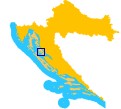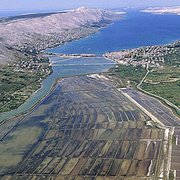Pag
|
|
Pag (Latin pagus, village) is an island in northern Adriatic Sea, off the coast of Croatia. It is the fifth largest island on the Croatian coast, and the one with the longest coastline.
The population of Pag is 7,969 (2001). In addition to the towns on island, Pag and Novalja, there are also many smaller villages and touristic places. The island is administratively divided in northern part which belongs to the Lika-Senj county and southern part which belongs to the Zadar county.
Pag is also the name of the largest town on the island of Pag, with a population of 2,421 (2001), located at Template:Coor d.
Geography
Pag belongs to the north-Dalmatian archipelago and it is extended northwest-southeast along the coast forming the Velebit channel. The island has an area of 285 km² and coastline of 302.47 km. It is around 60 km long (from northwest to southeast), and between 2 and 10 km wide.
The southwestern coast of the island is low (the Pag Bay with the large Caska Cove), and the north-western is steep and high: (Stara Novalja Bay). Most of the island is rocky; smaller areas are covered with Mediterranean shrubs. The southeast of the island contains karst lakes Velo Blato and Malo Blato. The island's highest peak is Sveti Vid (St. Vitus, 348 m).
Vine (the authentic sort of žutica), vegetables and fruit are grown in the valleys and fields. The area of the Lun peninsula is mostly under olive-groves. Major places on the island are connected by a road and a 300m-long arch bridge. There are also ferry connection to the mainland on the norther part Prizna - Žigljen. Major ports and villages are Lun, Stara Novalja, Novalja, Kolan, Šimuni, Metajna, Pag, Dinjiška and Povljana.
History
The mediaeval Pag emerged near the salterns where the abandoned Old Town used to be, 3 km south of the present location. According to historical documents, the name Pag was mentioned for the first time in the 10th century. In 976, the Croatian king Stjepan Držislav took Pag from the Byzantine authority and appointed a Croatian district Prefect as the administrator of the town.
Pag2.jpg
In 1244 Croatian-Hungarian king Bela IV granted Pag the status of a free royal town. After the rebellion against Zadar, Pag obtained partial autonomy, and Ludovic I acknowledged its full autonomy in 1376 as to all other Dalmatian towns. In the battles against Zadar which took place in 1394 Pag suffered a heavy defeat and devastation, and the inhabitants moved to a new location, where the present Pag was founded.
In 1403, the king Ladislav sold his share of Dalmatia, Pag included, to Venice and thus sentenced Pag to a centuries-long life under the Venetian rule. In 1433 Pag received the Town Statute, one of the first documents of that sort in Croatia.
In the middle of the 15th century, Ottoman threat kept rising and therefore the inhabitants of Pag decided to build a new town. The construction works began on today’s location of the town, on 18th May 1443. The urban plans of the new town were developed in Venice respecting the principles of architecture and urbanism of that time. Juraj Dalmatinac, a great constructor and sculptor participated in the development of the urban plan.
In the late 19th century and the early 20th century, the town of Pag had 4700 inhabitants. In later years, and especially in 1905, following the emergence of a blight, which had destroyed the vineyards, the number of population started declining. Many inhabitants emigrated, mostly to the USA, Canada and Australia.
During World War II, a concentration camp was set up on the island of Pag by the Croatian Ustaše puppet regime. It held about 8,500 people: 4,500 Serbs, 2,500 Jews, and 1,500 Communists. When the Ustaše learned in 1941 that the island of Pag was to be transferred to Italian control, they killed all of the prisoners.
Another wave of depopulation of town and island Pag took place at the end of the Second World War. In this period, the nobility completely ceased to exist.
During the War of Independence in 1991, the only link between southern and northern Croatia was the island Pag, thanks to the bridge that connects it to the mainland on the south and a ferry line on the north of Pag.
Cultural heritage
In 1443 the new town was founded and built according to new principles of town-planning. The longitudinal and the transversal streets, the latter known as Vela ulica, intersect at a right angle, forming in this way a rectangular square with the Collegiate Church, the Duke's Palace and the unfinished Bishop's Palace, which, as well as the town walls, were built by the famous mason and sculptor Juraj Dalmatinac.
The Collegiate Church is a three-nave basilica with three apses. The simple front is decorated with a Gothic portal, a Renaissance rosette and unfinished figures of the saints. In 1466 Juraj Dalmatinac became supervisor of the construction works on the church, while the building itself was carried out by his disciples; finished not before the beginning of the 16th century; restored in the 18th century, when the stucco work on the ceiling was performed. The church accommodates valuable works of art: the altar painting Our Lady of the Rosary, the Gothic wooden cross, and the silver processional crucifix and reliquaries are safeguarded in the treasury. The bell tower with its present height was erected in 1526.
In the Benedictine church of St. Marguerite, constructed after the plan of Juraj Dalmatinac, a silver processional cross and reliquaries are kept. The church of St. George, bearing Renaissance features, is a work of local masons from the 16th century.
There are several houses and smaller palaces with Renaissance fašades, portals and coats of arms of local noble families in the town.
The Old Town includes partially preserved walls and the main church, a three-nave basilica built in the Romanesque style; the fronts of the Romanesque and Gothic styles were built in 1392 by the sculptor Paul from Sulmona. The ruins of a Franciscan monastery from 1589 are near the church.
Economy
Traditionally, cattle and sheep breeding, along with the salt manufacture, fishing and agriculture has been the basis of the survival on the island throughout the centuries. The tradition of salt manufacturing most probably originates from the times of the first settlement in this area.
These traditianal branches are kept until today. Presently, there are around 40.000 sheep on the island. Today, around 33,000 tons of salt yearly produced, make 2/3 of the total production in Croatia. The salt basins spread over 3,01 km².
Anyway, today the most important economic branch, not only for the inhabitants, it tourism. Tourism on the island of Pag has seen its boom in the last decades. A large, well-maintained public beach, particularly suitable for families with children, lies not far from the centre of the town. The famous lacework of Pag, the best-known national lacework, is produced here, and in the local cheese-monger's shop one of the most famous authentic national sorts of cheese - the cheese of Pag. The prominent national costumes are also categorized as national souvenirs. The present rich touristic offer of Pag, which - along with the impressive landscape - stone lace in the sea - make Pag and the Pag Bay an exquisite tourist resort.
External links
- Pag island (http://www.otokpag.com/)
- City of Pag (http://www.pag.hr/)de:Pag


